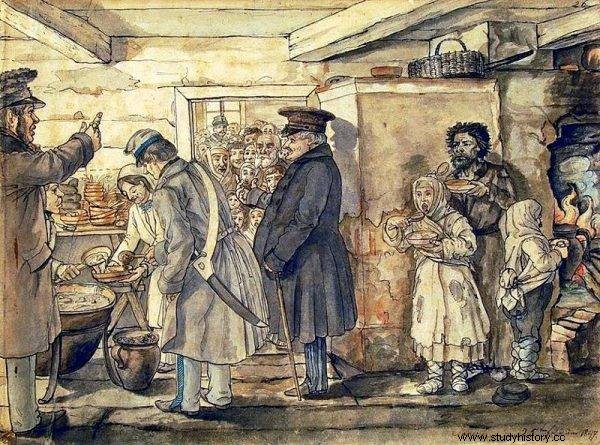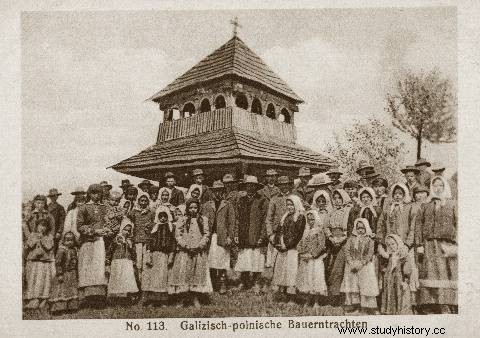Galicia at the beginning of the 20th century was a backward, poor region where various nationalities, political options and social groups clashed. What was the everyday life of its inhabitants like?
Peasants made up the vast majority of the Galician population in the first years of the 20th century. Of the 7,316,000 inhabitants, only 20% lived in cities, and only about 2,300 were landowners (including families, about 12-15,000). But it was they - along with priests - who had the greatest impact on the lives of over 6 million people.

Many peasants under the partitions lived in extreme poverty.
At the beginning of the century, this narrow, privileged group was forced to fight to maintain the privileges. From the 1870s, farms were slowly declining. There were more debtors. The estates often changed their owners. Witold, Fr. Czartoryski complained to other owners: "the earth is being removed from our hands [...], manors are dismantled for bricks, forests are cut down, trees are cut down from the gardens for perennials" .
The landlords themselves were guilty of it. The indirect reason for the decline in their income was the flooding of the market by cheaper grain from the United States, but - above all - it was due to economic backwardness, aversion to technological innovations, and at the same time - a love of feasting and living beyond their means. In some Galician counties, as many as 80% of landowners were heavily indebted. And the poor condition of the economy worsened the already difficult situation of the poorest - the peasants.
The poverty squeaks
As in the higher, aristocratic or bourgeois classes there were richer and poorer ones, also among the peasants one could find those less and more wealthy. The latter were few, but they could boast of large farms with separate stables, where they raised a larger herd of cattle and horses. Often they hired a farmhand or two to do most of the work.
There was a bit more so-called farmers who owned 2 to 5 hectares of land; two, less often three cows, and often even a horse. The bailiffs were the poorest and the most numerous group. They did not own land, except for a small plot behind a one-room hut, where sometimes there was room for a cow or goats . Farmers and farm workers were recruited from among them. In fact, there was not much difference in the standard of living between the last two groups. Everyone was in the same poverty.

The situation has not improved at all over the years. In Fig. distributing meals to the poorest in the mid-nineteenth century.
The richest peasants built two-room houses. Sometimes there were even cottages with three rooms - these were the property of teachers, village leaders and foresters. However, most of the huts were single-roomed, and the stables passed through the hallway. Elżbieta Dolata describes the farms at that time:
Household appliances consisted of a table, a pair of benches, chests serving as wardrobes and beds. In addition, the room often had querns for grinding grain, a walk for grinding millet, moss, and lining for oil. In addition, there was a barrel with cabbage in the room, and there was also a supply of potatoes for the winter.
The walls of the houses were whitewashed once a year, mostly at Easter. In each room there were two beams under the wall, the so-called the south, where firewood, flax and hemp were dried, and there were also loaves of bread. The floor was replaced by compacted clay. There were no wardrobes for clothes, everything hung on poles in the room, hall or in the chamber.
Most of the space in the room was occupied by a large, brick stove on which one could sleep. Almost all houses already had chimneys. Usually brick, less often clay. However, there were also huts.
(...) the living room was haphazard, one room and a kitchen were enough, one bed was enough. Two beds was a luxury. Sometimes there was even no table, and people ate on the bench from one common bowl. One bed was enough because the family, however large, was located anywhere. The smaller ones slept on the benches and stoves. The larger ones slept in cowsheds and stables in winter, and in attics and sheds in summer. The cover did not cause much trouble, because sheepskin coats played this role very well, and finally it was possible to make such a cover from a sackcloth filled with oat chaff.
Empty pot
Due to the prevailing poverty, the peasants' diet was not particularly varied and plentiful. The poorest usually ate two or three meals in the summer. The richest five. The food was cooked in clay, less often in cast-iron, pots. Potatoes were the leader, and they were often eaten for every meal, although a few years earlier they were considered poison, and ashes and priests categorically advised against eating them. At the beginning of the century, there were from 1 to 4 kilograms of potatoes a day per inhabitant of Galicia. Vegetables and legumes were the staple of the menu.
They plant lavishly cabbage, beans, pumpkin, corn, beets, carrots, parsnips, turnips, cucumbers, beans, garlic, parsley, poppy seeds and linseeds. [...] The common people neither know nor use greens and salads. They pick mushrooms, but mostly for sale, they eat less themselves.
In some regions, bread was a delicacy. "Only richer peasants, about 10% of the rural population eat rye bread every day, often with an admixture of barley" . Usually potatoes or a medium grade flour were added to the bread. The wheat bread was on the tables only during ceremonies or on the occasion of receiving guests.

Postcard from Galicia
The meat was served only on important holidays. In richer homes - sometimes on Sundays. Its consumption was a sign of wealth, so the beatings of pigs were flaunted, and the purchases were carried ostentatiously through the countryside for everyone to see. Equally exclusive were eggs that "were used almost only for Easter or for the sick, or the hostess fry them for a guest, for example a priest, when he went after a Christmas carol, considering it the best party and treat".
Educated in faith
The position of the clergy was very high. Alongside the heirs, the clergy constituted the supreme authority, and their word was literally sacred. By putting pressure on superstitious and illiterate people, priests subjugated him in every aspect of life. Indoctrination began from an early age - already in school, which was generally considered unnecessary. There was an opinion among peasants that "it is not worth teaching a child a lot, because it is unnecessary to a peasant in the countryside, because it will not give bread anyway" . In fact, ignorance was cultivated:"if you know what writing, your breasts will be pushed to hell."
As many as three out of five thousand schools were one-class schools, where education lasted from autumn to spring, when children were not needed on the farm. Basic skills were taught there:reading, writing, accounting, singing, and the girls additionally sewing. But the most important thing was to educate in faith.
"The first tasks of the school should be to guide students to learn and perform all the duties that every Christian-Catholic should know and perform" - wrote Bolesław Baranowski, a member of the Pedagogical Society. The Church defended itself by all possible means so as not to lose control of the schools. Those who postulated to use the model known from France, where religion was brought out of schools, were threatened with excommunication.
Even after the introduction of state education, priests - due to their position - were left in school councils. Therefore, they continued to have a great influence on the education of the peasantry. An influence that in no way improved the well-being of the poorest, because "many of them never learned anything, and only took from this teaching severely strained ears, which the parish priest used to stretch every day."
"Real Poles"
At the beginning of the 20th century, political agitators also reached the villages of Galicia. For over fifty years, the sons of landowners and priests had been sent to serve the state, and the peasants' aspirations for freedom were awakening. In Galicia, the problem was special because several national groups lived next to each other. The aristocracy was afraid that the Polish land would fall into Ukrainian hands. That is why the Democratic Party's postulates excellently reached the upper classes of society.
Endeks proclaim that only they are real Poles and Catholics, the rest are Jews, Masons, godless people, sodomites and various candidates for hellfire. our neighborhood is almost gone, some agitators will appear before each election but will disappear again after the election until the second election.

The houses were mostly unicameral, there were also huts.
It was different among peasants. In 1906, conservative journalists from Gazeta Narodowa complained that “we face this society every day, an enemy for us, different from us […]. The dark Ruthenian masses still have the instincts of nomads who crave not good and normal working conditions, but someone else's forests and pastures. "
The political struggle intensified. The Earthlings were hoping to maintain the status quo , peasants - to improve their fortune. The construction of schools and churches was started, thanks to which education and the Roman Catholic faith were to be spread. The atmosphere of a besieged fortress was built, which could only be defended by the aristocracy and priests.
In 1907, "Gazeta Narodowa" called:"so long as we have the land under our feet. To defend this land, to keep this land, it is our duty […]. Manors for the future of the nation and for social balance are a historical necessity ...
Right before the outbreak of the war, Galician society was deeply divided. Under the guise of a national movement, the landed men continued their business and bargained with their Austrian, Hungarian and Czech counterparts. The peasants, on the other hand, continued to live in poverty, prayed and hoped for an improvement in their fate. Mainly by going to America.
Bibliography:
- Dolata E., Galician childhood at the beginning of the 20th century in the light of peasant diary literature , [in:] Przegląd Pedagogiczny, No. 1/2012.
- Franaszek P, Diet of the Galician peasants at the turn of the 20th century, [in:] Annals of social and economic history, vol LXXVI, 2016.
- Semczyszyn M. The crisis of the gentry in Eastern Galicia at the turn of the 19th and 20th centuries (until 1914), [in:] Scientific journals of the Jagiellonian University, Historical Papers 146, 4/2019.
- Semczyszyn M., Socio-political attitudes of the East Galician gentry
- in the light of the Lviv "Gazeta Narodowa" (1886-1914) [in:] Society - politics - culture. Studies on the history of the press in the Second Polish Republic , Szczecin 2006.
- Słomka J., Diaries of peasants from serfdom to the present day , Tarnobrzeg 2008.
- Wałęga A., The image of religious education in Galicia in the second half of the 19th century in the opinion of the collaborators of the Lviv "School", [in:] Paedagogia Christiana 1/39 , 2017
- Witos W., My memories , Warsaw 1978.
